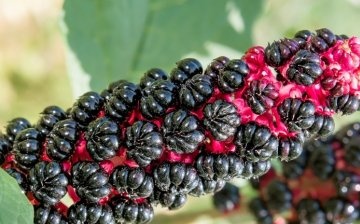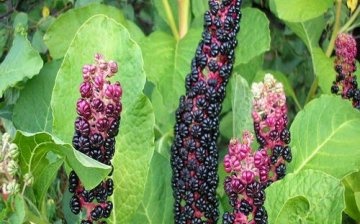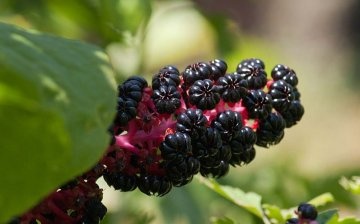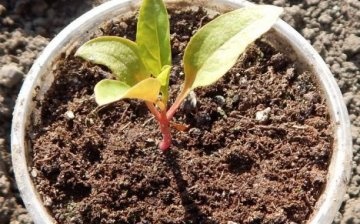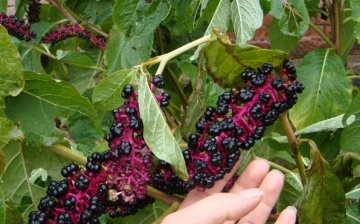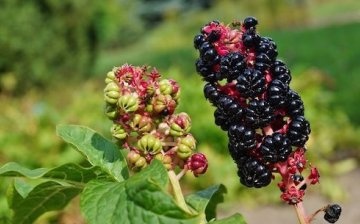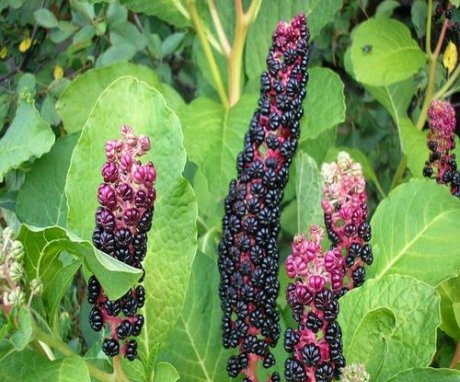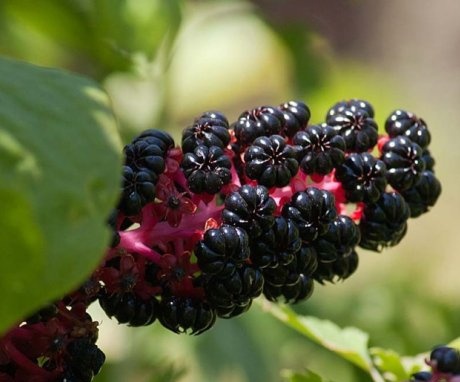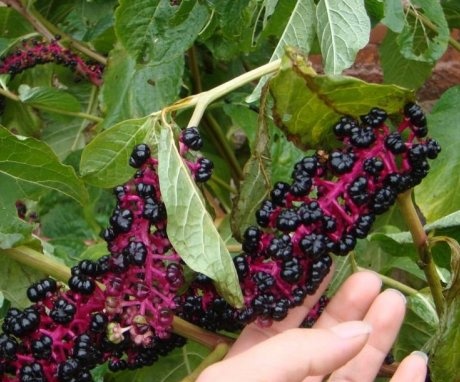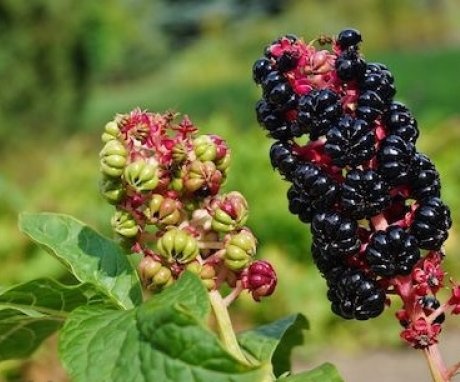Phytolacca - exotic and medicinal shrub in the garden
Phytolacca is an unusual plant for a region with a temperate climate and is rarely found in the gardens of summer residents. However, it is worth paying attention to. Lush bushes, candle-shaped dense inflorescences and bright fruits will decorate the site throughout the season. At the same time, the plant is quite unpretentious.
Fine bushes of Fitolacca.
general information
Phytolacca is a perennial plant that grows in the form of a bush and belongs to the lacunar family. Under natural conditions, it grows in America, but over time it migrated to the Eurasian continent. It is currently cultivated as an ornamental and medicinal plant.
On the territory of Russia, phytolacca is rarely found in gardens, but, despite the fact that the plant is tropical, he also liked the cold climate.
Features of the structure:
- In temperate climates, the stems stretch 1.5 meters in height, while in native conditions this figure is 2 times more.
- Root system the plant is represented by a rod-shaped thick rhizome that goes deep into the ground and lateral growths, with which the plant can be propagated.
- Stems are strong, smooth, strong branching in the upper part. They are colored green or reddish.
- Large leaves on the branches are arranged alternately. They are ovoid, ribbed, with pronounced veins and can reach 25 cm in length. The leaves are painted green or dark green.
- Phytolacca blooms almost all summer. The buds are collected in large inflorescences, which outwardly resemble chestnut candles. The flowers are small, outwardly reminiscent of stars, the petals are painted in a light pink tone. During the budding period, the bush has a very beautiful appearance. After the appearance of fruits, its decorative effect improves.
- Small berries in a ripe state of dark purple, almost black tone, collected on the cob remain on the bushes until frost. One fruit consists of 10 lobules, in which there are and ripen the seeds... Berries during the ripening period change color from light pink to dark purple. At the same time, on the cob, the fruits begin to ripen from the bottom of it.
Care
Phytolacca can be attributed to those exotic plants that do not require special care and at the same time annually give a large increase in greenery and abundant bloom... Despite its tropical origin, it grows and develops in almost any conditions.
For phytolacca, choose a sunny place for planting with shading from direct rays. The soil should be fertile and loose enough. But the plant can grow well in any place.
It does not tolerate stagnant water, so the place should be on hills or slopes, but not in hollows and depressions.
He loves water, therefore watering should be regular. This is especially true for young representatives in the hot summer period. But the plant can be classified as drought-resistant, since an adult phytolacca, thanks to its powerful rhizome, which goes deep into the ground, can get moisture from the soil on its own. Also on hot days, you can spray the bushes with hoses to provide additional moisture for large leaves.
In the spring, all the bushes need to be fed. For this, organic and mineral fertilizers... They are brought in together with watering, alternately 1-2 times a month. The process is repeated throughout the season. You need to pay attention to the compositions top dressing, an increased nitrogen content will increase the greenery, but will reduce the number of flowers and, accordingly, fruits. Phytolacca bushes do not need pruning. Every year before wintering, the upper part withers and dies off. The plant is sensitive to both spring and autumn frosts, therefore, it is covered first and opened even when the weather stabilizes and there will be no night frosts.
Phytolacca is a tropical plant. And, despite the fact that it has taken root in a temperate climate, it must be insulated for the winter period:
- To do this, before the frost, the entire aboveground part is cut off so that 10-15 cm remain on the surface.
- After that, the bush is watered and, after all the water is absorbed, covered with spruce branches, sawdust, straw, foliage or peat for the winter.
Reproduction
You can propagate phytolacca using seed and dividing the rhizome. Moreover, both methods are effective and have 99% survival of a new plant. Seeding and sowing can be carried out on the same day. At the same time, small depressions are made in the prepared place, into which the fruits with seeds are placed, without clearing them of pulp.
This process is usually carried out at the end of summer, the seedlings must be looked after, and for the winter they must be insulated with peat or spruce branches. The next year there will be no flowering, during this period the bush will begin to strengthen the root system and grow. The second year will bring rare inflorescences. The plant acquires decorativeness at the age of 3. The bush becomes lush and large.
If the fruits are not removed from the bushes and left until late autumn, then they will scatter on their own, and in the spring new shoots can be found around the bush.
They can be carefully transplanted into a permanent place along with the part of the ground where they grow, so as not to damage the still fragile root. When phytolacca multiplies by dividing the bush, you get an adult plant as a result:
- The process is carried out in the spring months, when the weather is stable and warm and the ground has warmed up.
- Reproduction by dividing the rhizome can only be carried out with a plant that has reached 5 years of age.
- The bush is carefully dug in from all sides and taken out of the ground.
- The root system is cleared a little and at this point it is necessary to inspect how many incisions can be made. At least 3-5 shoots should remain on each hotel plant.
- They land in pre-prepared recesses. It should be borne in mind that phytolacca grows rapidly, annually increasing the green mass. Therefore, the bushes are planted at a distance of at least 1 meter from each other and from other plants.
Diseases and pests
Phytolacca is resistant to various common diseases, therefore, if the plant begins to wilt or disappear, this indicates improper care or oversaturation fertilizers and top dressing.
Another advantage of this plant is that it is not attacked. pests... Moreover, it scares away insects from everything that grows nearby. Therefore, phytolacca is planted in gardens as a protection against pests.
Application
The main use of phytolacca in our region is decorative... It can be used as a separate planting or combined compositions. Plant as a live fence or in the center flower beds... Wherever you place this extraordinary bush, it will always attract attention with its unusual appearance and colorful fruits.
Also, this plant is used for medicinal purposes.
The root is harvested in the autumn. Usually, those appendages that are visible on the surface are suitable for this. They are carefully separated from the bush, cleaned and washed in water.On the cut, the root should have a yellowish-white color, with a red color in the pulp, the root is not used. Tinctures are made from dried or fresh roots, which are used as a laxative, wound-healing or bactericidal agent. Also, ointments are made from it, which help in the treatment of lichen. And fresh leaves are often used for furunculosis, growths, lichen and similar skin diseases. In this case, it must simply be separated from the bush, rinsed and applied to the sore spot.
During the manufacture of tinctures and ointments and when using medicines from phytolacca, you should be careful and attentive. Overdose will lead to undesirable consequences. Phytolacca is an unusual, but quite colorful and beautiful plant that should be in every garden. It will delight you with its greenery and flowering, as well as with skillful use, it will help to cure simple diseases. By planting one bush on your site, you can subsequently get a dense and beautiful garden.
More information can be found in the video.



